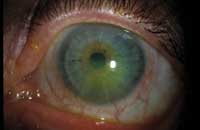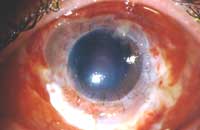CLAO presentations highlight therapeutic contact lens use
CLAO researchers discussed the use of GP lenses for corneal healing and pain relief, as well as stem cell and graft transplants for restoring the epithelium.
ORLANDO, Fla. – Presenters here at the Contact Lens and Eyecare Symposium highlighted current theories for promoting epithelial healing — especially with the use of gas-permeable lenses — in Contact Lens Association for Ophthalmologists (CLAO) sessions and poster presentations.
Scleral GP contacts
|
Ann Laurenzi, OD, of the Cleveland Clinic Foundation’s Cole Eye Institute, cited how therapeutic scleral GP contact lenses can be used to promote earlier epithelial healing in defects of this outermost corneal layer. These lenses may provide therapeutic benefits to patients with ocular surface disease such as Sjögren’s syndrome, dry eye, atopic keratitis sicca. The lenses also may help to relieve eyes with persistent epithelial defects, and provide visual rehabilitation to patients with keratoconus and pellucid marginal degeneration.
According to Dr. Laurenzi, healing is promoted when migrating epithelial cells are protected. She explained, “When there is cell migration and mitosis, the contact lens provides a protective barrier to allow formation of hemidesmosomal adhesions and adherence of the epithelial cells to the basement membrane. These lenses are now available in higher oxygen-permeable materials, providing an overall better atmosphere and, thus, sufficient oxygen supply to the diseased ocular surface.”
She said studies indicate that if the GP contact lens has a Dk range between 87 and 125, it reduces or eliminates the normal sequelae of hypoxic events such as edema, microcysts and neovascularization.
Dr. Laurenzi said that eyes with ocular surface disease may benefit from “fitting and prescribing a larger diameter GP lens, particularly a scleral GP contact lens that vaults the cornea and limbal area to further protect and hydrate the ocular surface,” she said. “Pain relief is provided for these patients with this contact lens, because the large diameter effectively protects the entire cornea, which may be better than patching, as movement of the eye causes mech-anical friction between the eyelid and corneal epithelium.”
Conjunctival transplantation
David M. Meisler, MD, also from the Cole Eye Institute, discussed conjunctival transplantation for restoring the diseased ocular surface in patients with pterygia and cicatricial conjunctival disease. He said that a conjunctival auto graft is performed by removing the abnormal conjunctiva, preparing the scleral bed, harvesting the graft, then suturing it onto the sclera.
Stem cell transplantation
|
Patients who have aniridia, idiopathic absence of stem cells and Stevens-Johnson syndrome or who have suffered alkali burns to their corneas have stem cell deficiencies and may require stem cell transplantation, said E. Lee Stock, MD, of the Medical College of Wisconsin Eye Institute in Milwaukee. Dr. Stock described this procedure at the meeting.
Stem cell transplantation was developed from the pioneering work of Richard Thoft, MD, who described kerato-epithelio-plasty, in which the lenticles of limbal cells from a whole globe of a donor eye are sutured into the limbus of a denuded corneal epithelium. This procedure was modified by Dr. Stock to include the whole limbus, and by Dr. Edward Holland, who suggested using 1.5 donor corneas to provide more stem cells.
“Postoperative therapy consists of ophthalmic medications for up to 1 year and, for some patients, a therapeutic soft contact lens worn 1 to 2 weeks,” Dr. Stock said.
Omega 3, omega 6
A poster presentation based on a study by Jeffrey P. Gilbard, MD, showed that women with a higher dietary intake of omega-3 essential fatty acids have a decreased risk of developing dry eye syndrome. The major source of omega-3s in the American diet is tuna fish, and there was a statistically significant reduction in dry eye risk with increasing intake of tuna fish, Dr. Gilbard explained. However, Dr. Gilbard said that in this study of 32,470 women, increased dietary intake of omega-6s increased the risk of dry eye, negating the benefits of omega-3s in those patients with high omega-6 intake.
Post-surgical reverse geometry lenses
According to study results from Steven Mathews, OD, PhD, myopic refractive surgery and penetrating keratoplasty occasionally result in irregular oblate corneas that require a reverse-geometry design to center well. This is especially important for night driving clarity, as these lenses typically have a smaller optical zone, he said.
“Large-diameter, conventional diagnostic GP lenses can be used to find the reverse curve radius with the base curve of the flattest conventional trial lens that centers serving as the reverse curve. In addition, the over- and manifest refractions and trial lens power can be used to determine tear lens power under the conventional trial lens; subtracting the tear lens power from the reverse curve yields the base curve of the ordered reverse geometry lens,” he said. “The peripheral curves outside the reverse curves are simply taken from the large-diameter conventional fitting set.”
Paragon CRT study
Penny Asbell, MD, and colleagues evaluated patients using the Corneal Refractive Therapy system, by Paragon (Mesa, Ariz.), to correct their myopia with specially designed GP lenses. Seventy-five percent of the patients had uncorrected visual acuity of 20/200 or worse. There were 20 patients, with 39 eyes evaluated. The researchers saw improvement the first month, with 88.46% reporting UCVA of 20/20 or better and 100% achieving 20/40 or better.
Their poster explained how topography with a Holladay Diagnostic Summary using an EyesSys200 Video-keratoscope provided refractive power, corneal shape and optical quality of the corneal surface at every point. A refractive yield (uncorrected achieved VA/ attempted VA) of the achieved or attempted correction to account for distance UCVA or monovision showed that all patients improved, with 96.7% after 1 month and 99% at 3 months. Dr. Asbell emphasized, “Corneal quality was maintained.”
|
|
The researchers concluded that CRT is a safe and effective alternative to refractive surgery — and it is reversible.
A note from the editors:
This article was previously published in Primary Care Optometry News, a SLACK Incorporated publication.
For Your Information:
- Ann Laurenzi, OD, can be reached at Cleveland Clinic Foundation’s Cole Eye Institute, 9500 Euclid Ave., 120, Cleveland, OH 44195; 216-445-2196; fax: 216-445-2272.
- David M. Meisler, MD, can also be reached at the Cole Eye Institute, 216-444-8103; fax: 216-445-8475.
- E. Lee Stock, MD, is a professor of ophthalmology at the Medical College of Wisconsin Eye Institute, 925 N. 8th St., Milwaukee, WI 53226; 414-456-7842; fax: 414-456-6300.
- Jeffrey P. Gilbard, MD, is the founder of Advanced Vision Research. He can be reached at 2 Alfred St., Ste. 200, Woburn, MA 01901; 781-932-8237, ext. 111; fax: 781-935-5075.
- Steven Mathews, OD, PhD, is an associate professor at Texas Tech University Health Sciences Center, Department of Ophthalmology. He can be reached at 3601 4th St., Lubbock, TX 79430; 806-743-9500 ext. 257; fax: 806-743-2471.
- Penny Asbell, MD, is a professor of ophthalmology and director of cornea and refractive surgery in the Department of Ophthalmology, Mt. Sinai Hospital School of Medicine. She can be reached at Box 1183, Annenberg Bldg. 22-11, New York, NY 10029-6574; 212-241-7977; fax: 212-241-4550.
- Barbara Anan Kogan, OD, can be reached at 4501 Connecticut Ave. NW, Ste. 102, Washington, DC 20008-3711; 202-244-1324; fax: 202-244-1324.
- More information on dry eye – from numerous optometry and ophthalmology organizations — is available at www.dryeyeinfo.org.



